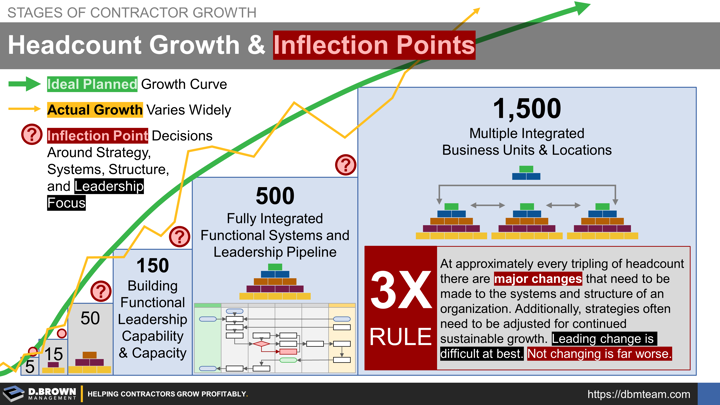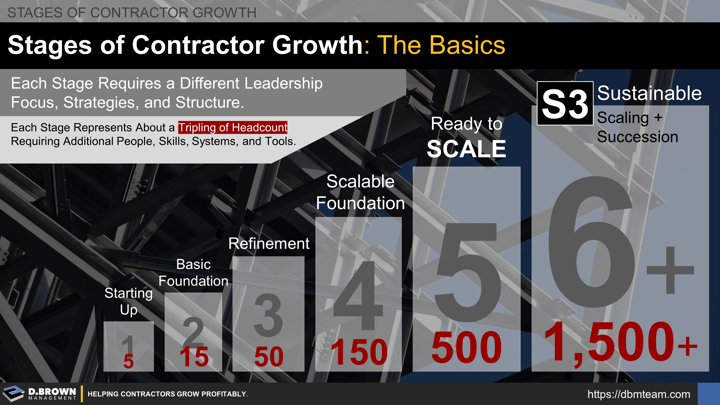The tripling of headcount rule of thumb shows up in organizational structures all over the world and throughout time. The scientific theories behind that largely come down to communication and the network of relationships that holds groups together, which we will dive into later. The important thing for owners, leaders, and managers of construction contracting businesses to focus on is that each stage requires:
- Different strategies around markets, geography, customer, scopes of work, delivery methods, operational capabilities, and talent. Example of growth strategy using preconstruction services and what business development principles look like for one of the largest contractors in the world.
- Different organizational structures that balance efficiency and quality of decision making with development along with focus on the capabilities required to execute the evolving strategies.
- Different management systems.
- Different communication systems to keep everyone aligned with the exponentially growing number of relationships that come with headcount growth. This alignment starts with trust.
- Different phases of growth for the management team within each of the stages of growth.
- Increased difficulty of identifying the constraint and next 3-5 bottlenecks then prioritizing improvements as the business continues to grow in complexity.
- Different leadership focus at the top while not losing the prior focus at different levels of the organization.
As contractors navigate each of these stages of growth, there are inflection points where they must make these adjustments. These are not hard lines in the sand but occur in degrees over time and growth points. Contractors may be experiencing one or more of the items on this checklist when they are at an inflection point.
8 Indicators That You Might be at a Growth Inflection Point
Talent Planning, Structure, and Systems Example: The Project Management Function and Role(s) at Different Stages
Keep in mind that these are just typical examples of what is "normal" at each stage of growth and that "normal" is a range. It is "normal" for a contractor to be at the top end of the bell curve on one aspect and at the bottom end for another. Navigating a growth and development path that keeps everything reasonably aligned is the tricky part of leadership.
Starting Up:
- Likely no real need for dedicated project management.
- The owner handles what little project management work there is.
- Recruiting seems very reactive because there is little additional capital to hire in advance of actual project needs.
- "I need someone to help me build this job I just got!"
Scalable Foundation:
- Clear outcome expectations for the PMs but they have very little support.
- PMs are generalists doing a bit of everything, including estimating and purchasing.
- Some systems and tools, but their use is inconsistent with everyone doing things a little differently and largely based on systems and tools that they brought into the company from prior experience.
- Possibly some separation of roles but lots of overlap and inconsistency in responsibilities.
- "We need to hire 3 PMs this year to support our backlog and opportunity pipeline."
Sustainable Scaling and Succession (S3):
- 4-6 distinct roles make up the project management function with clear career paths and training for each role.
- Robust support functions including estimating, purchasing, contracts, virtual construction, and fabrication have narrowed the scope of the PM function.
- Clear outcome and process expectations for each role including management processes to ensure consistent outcomes.
- Talent pipeline ensuring required capabilities and capacity for long-term growth.
- Based on our business planning, market forecasts, known retirements, and historical turnover rates, we will need an additional 23 PMs in five years.
- Based on our current pipeline of talent that have the potential to be PMs over the next five years, and our career progression timelines, we will need 20 interns to accept full-time offers for PEs this year.
- Additionally, we will have to identify at least 20 craft or foremen that are interested in moving to a PE track over the next two years.
As you can see, these are very different structures for the PM function and very different time horizons for the talent pipeline. All are perfectly appropriate for the stage of contractor growth.
Diving Deeper into the Numbers and US Construction Market
Stages 1-6 in the diagram above represent a very large portion of the approximately 1 million construction contracting businesses in the United States. Approximately 60% of them have 1-4 employees, which is where every business starts. However, these are often short-lived or part-time businesses.
On the ENR Top 600 Specialty Contractors and Top 400 General Contractors, there are only about 100 of the largest contractors that have 1,500 or more employees. About 40% of the approximately 9 million people employed in the construction industry work for contractors between stages 3-5 in their growth. Stage 6 sized contractors employ about 10% of the workforce and another 10% for those few contractors in 5,000 - 45,000 employee range.
For simplicity in discussing these stages, we have named them as follows:
- Starting Up
- Basic Foundation
- Refinement
- Scalable Foundation
- Ready to Scale
- Sustainable Scaling and Succession (S3)
GOING DEEPER: Dr. Ichak Adizes has spent his life studying organizations around the world and dives much further into detail about the full range of organizational lifecycles, including many of the reasons companies fail at different stages and what the broader decline looks like since no country or company has withstood the test of time. His book on Managing Corporate Lifecycles, is worth a read if you want to go much deeper into the topic. We are focused on the elements of his model that we see most impacting construction contractors.
The 3X Rule and Organizational Group Sizes - Beyond Construction Contractors
One of the easiest places to see group sizes are within military structures around the world and throughout time. Consider some of the more common military organizational groups:
- Fire Team is 4 or less people focused on a specific task. In construction terms, think about an installation crew on a jobsite.
- Squad consists of 2-3 Fire Teams with 10-15 people total. Think about a Foreman running several crews.
- Platoon consists of 2-4 Squads with average size around 50 but may be substantially smaller or larger depending on the profile of the mission. Think about the dynamics of different types of projects where you would assign a higher-level General Foreman or Project Superintendent to lead the project.
- Company consists of 3-7 Platoons with headcount ranging from 100-250. Both of the dimensions (platoons and headcount) depend on the complexity and scale of the mission, similar to a contractor. The Company as a military unit has Platoons focused on logistical support for the other Platoons and a command structure holding everything together. Think about the different structures of two similar sized contractors but with one focusing on hundreds of special projects per year and the other focusing on a dozen larger projects.
- Battalion typically consists of 2-5 Companies and about 500 people though the range varies.
- Brigade is typically 3-6 Battalions depending on the mission and capabilities requirements.
Again, remember that the 3X rule is not a hard line in the sand. The variables on the 3X rule are in terms of complexity. For example, the organizational structure required to organize utility scale solar projects is simpler than organizing the same volume of EPC (Engineering, Procurement, and Construction) solar projects for commercial and industrial buildings. The contractor focused on utility scale solar may be able to stretch organizational structure changes to every 4-5X in growth while the EPC contractor may need to do this every 2X in growth.
GOING MUCH DEEPER: A good starting point if you wanted to go much deeper are studies by anthropologist Robin Dunbar including his paper called "Co-Evolution of Neocortex Size, Group Size, and Language in Humans." Basically, we need to be progressively smarter in certain areas to create the language, communications, and other supporting systems required to hold progressively larger groups of people together. It is easy to see intersections to the work done by Elliott Jaques and his Stratified Systems Theory (SST) which Tom Foster does a great job of explaining.
We exist to help contractors navigate these stages of growth more effectively and build stronger businesses for the next generation.
All relationships begin with a simple conversation. Please contact us to schedule some time to confidentially discuss your situation. We will freely share anything we know that will help.


